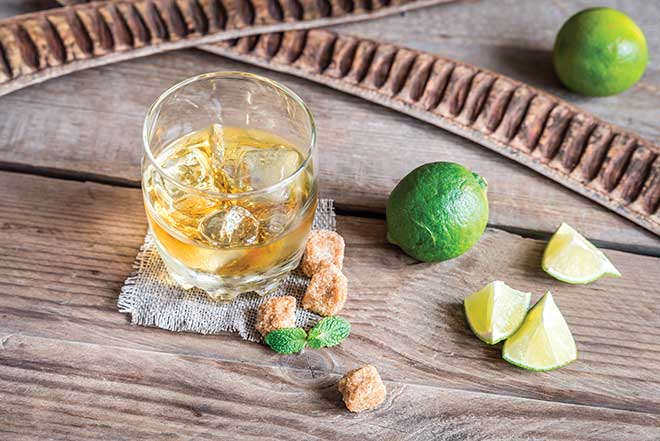Rum in its many forms and due to its versatility is a favorite spirit. My go-to summer drink is a premium rum and tonic with a lime wedge or slice of orange. There is a reason that the Royal Navy used it as part of the daily rations for British sailors for centuries—and that the practice wasn’t discontinued until 1970! During colonial times the tasty spirit was actually used as currency. In fact, the rum trade is part of the reason the colonies rebelled against Britain. It is that good.
Rum is a distilled spirit made from sugar cane—either from its juice or byproducts after refined sugar production, such as molasses. It comes in many styles, and unlike tequila and whiskies, there are no universal regulations on its production. Rules are designated by the country of origin and vary greatly. The majority of the world’s rum production still occurs in the Caribbean and the surrounding Latin American nations and is imbedded in their cultures.
rum styles
Light or silver, golden, flavored, spiced, dark and overproof rums are the main styles and these identify how the rums are produced and aged. The light and overproof rums are the ones traditionally used in cocktails with mixers, although in modern mixology, darker and aged rums also are being employed. Premium rums are the sippers. English-speaking nations tend to produce richer dark rums made from molasses and aged in oak. French speaking nations (Haiti, Guadalupe, Martinique) typically produce more expensive agricultural-style rums made from raw sugar cane juice in a lighter and aromatic style. Spanish speaking islands and countries produce aged rums (añejo). Brazil produces a rum-style spirit called cachaça.
sipping rums
Zacapa XO extra añejo—Guatemala Aged 25 years in cognac barrels gives it a winey fruitiness combined with notes of honey, nutmeg and cinnamon spice. $80
El Dorado 12 year—Guyana. We just added this to the hotel list, and it is fantastic. Against the 15-year, this drinks better at a fraction of the price. It’s smooth and fruity with a hint of baking spice. The tropical climate where it is produced ages the rum faster, and it drinks like a much older rum. $40
Santa Teresa 1796—Venezuela. This is the original Venezuelan producer and the first rum house to utilize the solera aging system. It’s a great dry sipper, with subtle hints of vanilla, dried cherry, caramel and toasted banana and is made with blends between 4 and 35 years. $35
Jeffrey Hall is the sommelier for The Four Seasons Hotel-St. Louis.
